The Vishera Review: AMD FX-8350, FX-8320, FX-6300 and FX-4300 Tested
by Anand Lal Shimpi on October 23, 2012 12:00 AM ESTProjected Performance: Can AMD Catch up with Intel?
I keep going back to this slide because it's incredibly relevant. It's the only indication we have from AMD of what its future roadmap will look like in terms of performance increases:
Each year AMD promised to increase performance of its high-end cores by roughly 10 - 15%. Astute observers will note that, at this rate, AMD will almost never catch up to Intel. AMD at the time was careful to point out that it's talking about 10 - 15% gains in core performance, and it could potentially see even larger increases in total chip performance by pulling other levers. Vishera is an example of AMD doing just that. The Piledriver cores by themselves don't increase performance tremendously, but they do give AMD a little more thermal headroom to work with thanks to some more efficient design decisions and better transistor choice. With Vishera, AMD took the additional power headroom and turned into a frequency advantage. The result is AMD's FX-8350 can operate in the same power envelope as the outgoing FX-8150, yet runs at an 11% higher base clock (turbo frequency remains the same). Through frequency and core level improvements, AMD was able to deliver a bit more than the 10 - 15% performance increased in promised.
If AMD is able to repeat these improvements again next year, I wondered whether or not it would get any closer to closing the gap with Intel - particularly when it came to single threaded performance. We already know from our Haswell investigations that Intel is expecting around a 5 - 15% increase in CPU performance from Haswell over Ivy Bridge. If we assume that Haswell delivers towards the 15% end of that spectrum, and if we assume that Steamroller delivers the same level of improvements that we saw from Piledriver/Vishera, we end up with some pretty interesting predictions for where things end up next year. I modeled the 2013 performance of high-end AMD and Intel platforms based on those two factors and plotted the curves in a few different benchmarks. For each generation I used the parts that AMD stacked up against one another (they are also fairly similarly priced). For 2011 I used the FX-8150 vs. Intel's Core i5 2500 and for 2012 I used the FX-8350 vs. Intel's Core i5 3570. The 2013 data is of course projected based on a 15% increase in performance from Haswell, and a repeat of the Vishera vs. Zambezi increase for AMD. This is mostly an interesting experiment so don't get too invested in the data.
We'll start with Cinebench, by far the most painful of the tests for AMD from a single-threaded performance perspective:
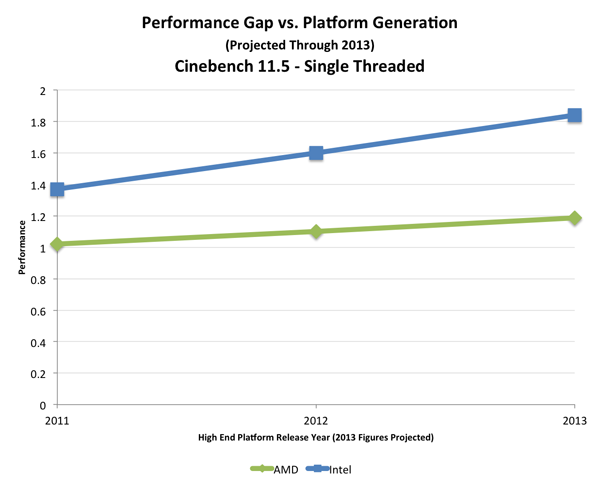
The Vishera gains here were decent but not enough to dramatically shrink the performance gap. Furthermore, Intel put a good amount of distance in place with Ivy Bridge and if it can continue that with Haswell I don't see much hope here.
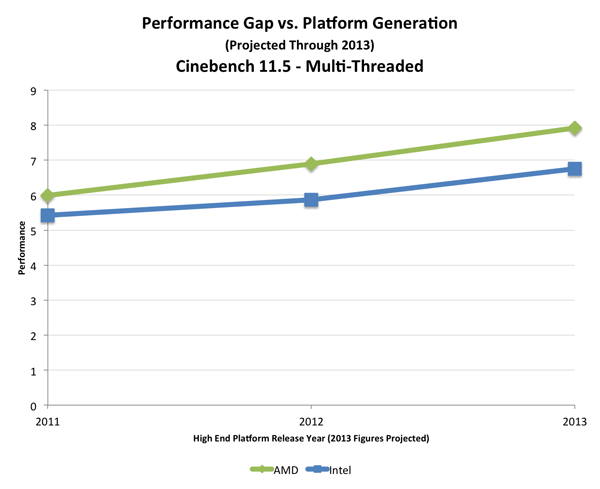
The multithreaded Cinebench results begin in AMD's favor and remain so even with our projected performance data.
Mozilla's Kraken benchmark is another example of single threaded performance gone awry for AMD.
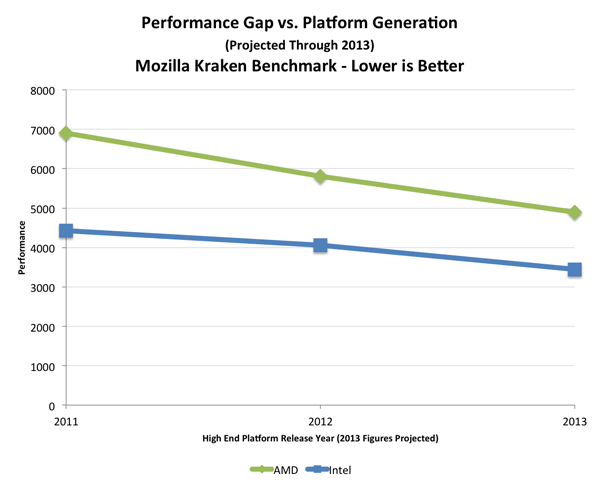
Thankfully, Vishera does close the gap by a decent amount and if AMD extends those gains it is on an intercept course with Intel. The bad news is, that intercept wouldn't be in 2013.
POV-Ray provides another point of view on single threaded performance, here the situation looks far less dire than under Cinebench:
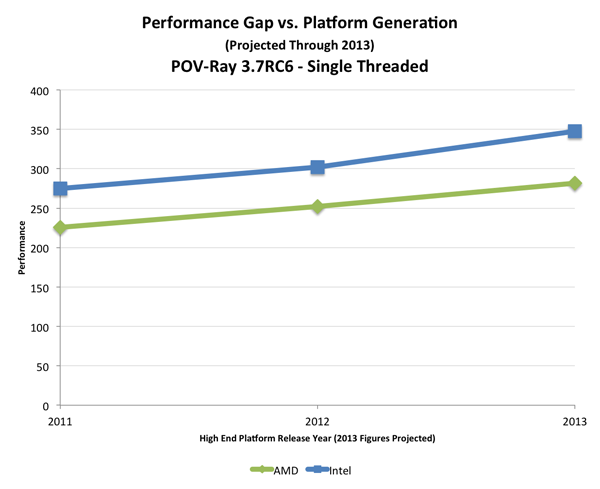
Unfortunately the curves remain fairly distinct.
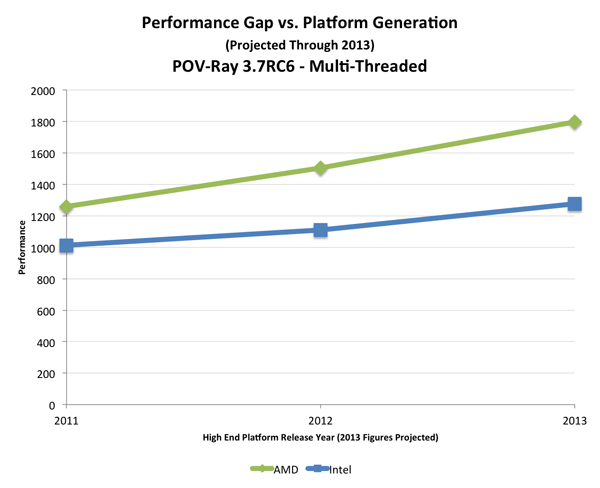
Once again, when we increase thread count we see AMD pull ahead.
SYSMark is a particularly telling benchmark as it is lightly threaded and does a good job of simulating all types of workloads:
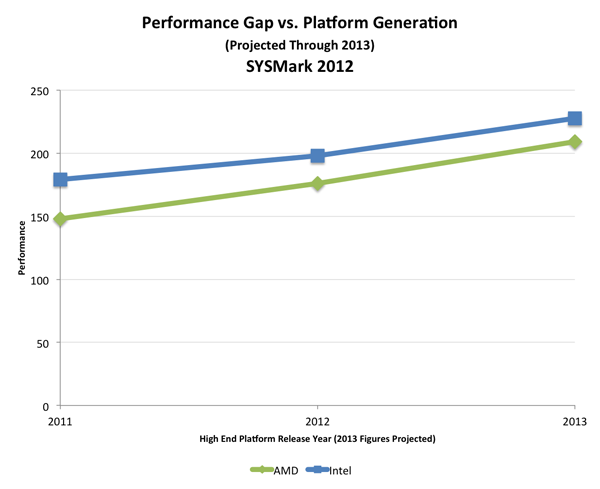
The result here is AMD closing in, albeit slowly, on Intel's performance advantage. I suspect this is quite possibly the best case scenario for AMD, it doesn't necessarily want to surpass Intel in performance but it wants to get close enough where pricing and other factors (e.g. GPU performance in its APU parts) can make a bigger difference.
Our Visual Studio 2012 test is a good combination of single threaded and multithreaded workloads in one:
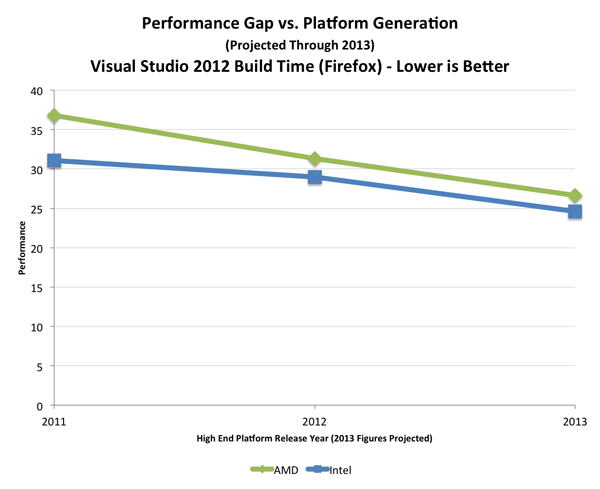
With Vishera, AMD did a lot to close the gap betwen itself and Intel. Another increase like this and we won't see AMD surpass Intel, but the two should remain fairly close.
These last two tests show us the other side of the coin. If both AMD and Intel continue on their present tracks, what will happen in a test where AMD already does well today?
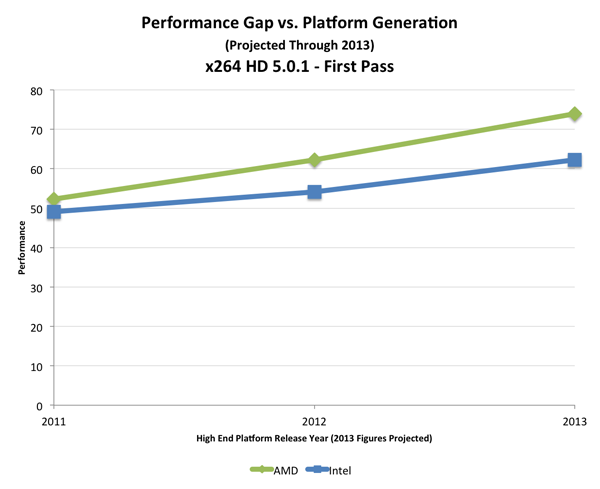
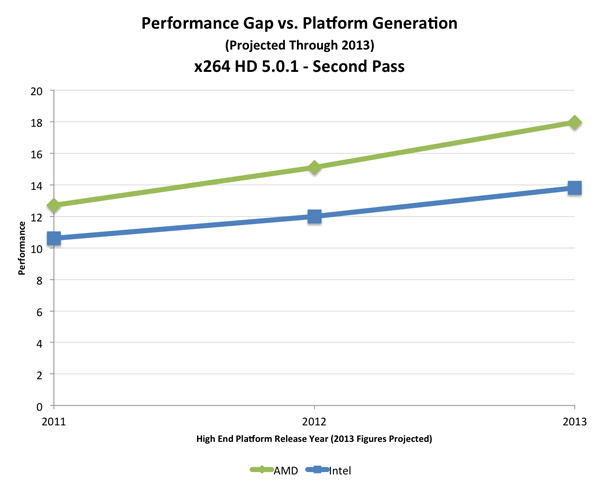
In areas where AMD holds a significant advantage, Haswell would need to deliver more than a 15% gain in performance at the same price point to catch up.
None of the results here are all that surprising. AMD remaining on its current course isn't enough to dramatically change its standings vs. Intel in another year. Vishera definitely cut into the performance delta, but the 2013 follow-up will have to do even more to really have an impact. Steamroller is far more focused on increasing IPC, however without a new process node it'll be difficult to demonstrate another gain in frequency like we see today with Vishera. I suspect the real chance for AMD to approach parity in many of these workloads will be with its 20nm architecture, perhaps based on Excavator in 2014.











250 Comments
View All Comments
CeriseCogburn - Tuesday, October 30, 2012 - link
So did you buy the i5 3470, or the FX 6200 ?According to you and your 1st chart, that's what "most of us bought". Okay, since we know that's total BS, what you said is also total BS.
" because most of us will buy the most performant processor per dollar "
LOL - okay, so there's a big problem bub - OC the 2500K and it skyrockets off the top of your 1st chart straight up.
So, did you buy the 2500K, like "most of us did" if we "used your declared knowledge about us all" and added 2 watts of common sense into the mix ?
Why must you people torture us so ?
Idiot10 - Tuesday, May 7, 2013 - link
Hey Mr. ChariseHogburn, why don't yoy take your 2500K with you and leave us all to our musings? You seem to know everything about processors why don't you let others do what they want to do? You big piece of Intel mercenary shit! SOB!!!!Mathos - Tuesday, October 23, 2012 - link
It does give a reason and an upgrade path to finally move up from my aging P2 1090T. One of the main workloads I do when I use my PC heavily is indeed easy h.264 encoding for game and other types of video. Always nice to be able to knock a video file down from 2.5GB to 200-500MB. I've personally always used MSI or ASRock boards myself, with some Asus boards when I can catch the price right, in reply to the board used for the benchmarks.I noticed there are overclocking numbers that do look decent. Some things I'm curious about. How do they take to undervolting? My luck with previous AMD generations has been pretty good when it came to that. At least when I felt like tinkering. Use to be able to run the old 9600be and 9850be considerably lower than stock voltages for example, at stock speeds, and some times even with mild overclocks on the NB's. I've noticed with that AMD tends to be fairly conservative.
And since they appear to still be using the same IMC/L3 speed linked to the north bridge hyper transport speed. How does upping the actual speed of the NB IMC/L3 effect the performance and stability of the platform. I know back in the day of the 9600be/9850be I could generally get them close to the same performance level as a core2 quad at the same clock speeds through that kind of tweaking.
And on a final note, it's a nice performance increase overall, even in single threaded apps, over the bulldozer cores. But you'd think they would of implemented a way to gang the integer cores and make them act as a single core for single threaded performance. That's all it would really take the pick up a bit of the slack I think.
jensend - Tuesday, October 23, 2012 - link
Why the heck are you starting your power consumption charts at 50W rather than at zero?That's *extremely* misleading, wildly exaggerating AMD's disadvantage. AMD has roughly 2x the power consumption of IVB at load and 1.25x the power consumption at idle- but by starting your chart at 50W you're exaggerating that into over 3x at load *and at idle*.
*Please* get yourself a copy of "The Visual Display of Quantitative Information" and read the section talking about the "lie factor" of a graph or chart.
Spunjji - Tuesday, October 23, 2012 - link
I think they are anticipating their readership noticing that the graph starts at 50W, just as you did.kevith - Tuesday, October 23, 2012 - link
They probably do. But that´s not the point. A GRAPH is meant to show a string of figures as a drawing.When a graph starts at anything but zero, it will not show a true picture.
With two pieces of something to compare, where both lay in the area between say 90 and 91 of some kind of value..
If you then make a graph, thats going from 89-92 in 1/10´s, you wil get a graph, that shows a very uneven curve, going up and down all the time, with seemingly big differences in values.
But if it started at zero, like it´s supposed to, you would see a almost straight line, reflecting the true picture: These two things are practically alike in this specific area.
IF you don´t make a graph like that ALL THE TIME, there´s no need to make a graph at all, you could just write the values as figures.
CeriseCogburn - Tuesday, October 30, 2012 - link
No spooge, it's called amd fanboy advantage, that is what should be always anticipated, and is actually always provided.Pythias - Tuesday, October 23, 2012 - link
Why was the i3 dropped from some of the charts?CeriseCogburn - Tuesday, October 30, 2012 - link
Because it kicked so much amd pileofcrap.redwarrior - Tuesday, October 23, 2012 - link
Anands testing was the usual lazy-designed testing with poor planning. Why run sysmark, that every one knows uses testing methods that tend to ignore multi-threading.. Keep the test on applications only and make sure your gaming apps are representative. I saw better testing done on several other websites where the usually poorly designed and coded trash was balanced with other games that did employ some level of multi-threading The FX-8350 did immensely better in that gaming selection. Mostl gamers are not shoot-em-up fascist gamers. There is no reason for Anand to stack the game selctions in the single-threaded direction only. I beleive Anand is a shill for Intel and chose the stupid sysmark tests and the game sin such a fashion to downplay the vast performance improvments that are possible from the FX-8350 cpu. That is one reason I do NOT spend much time on this site any more.There is nothing I detest more than intellectual dishionesty. Check out Tom's hardware their review was done more scientifically and had a balanced selection of tests. The Vishera FX-8350clearly bested the I5 3570 in most tests and was the best performance for the buck by far. A better objectively designed test. No axes to grind. To hell with Anand, unofficial Intel shill and LAZY intellectually.